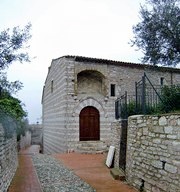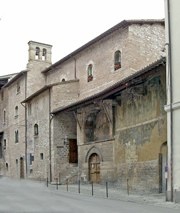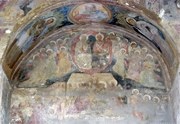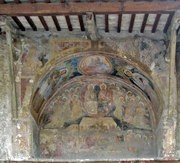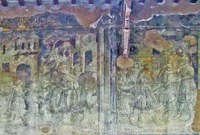


According to an inventory that was compiled in 1717 at the request of Bishp Palmerini, the Confraternita di San Gregorio was the first to be formed in Assisi and took precedence over all of the others. Bishop Teobaldo Pontano arranged for its meeting place to be moved to the present Oratorio di San Gregorio in 1325. Bishop Nicolò Sermattei suppressed the confraternity in 1772.
Exterior
Madonna and Child (ca. 1337)
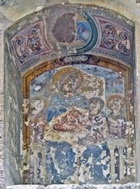
The original fresco depicted the Madonna and Child enthroned with SS Catherine of Alexandria and Clare. It was repainted in 1633, and figures of SS Francis and Gregory were aded at the sides of the aedicule.
Both Vasari and Fra. Ludovico mentioned a nearby fresco of the Flagellation of Christ, which they also attributed to Puccio Capanna. Fra. Ludovico also mentioned a third fresco of the Crucifixion, with the same attribution.
Interior
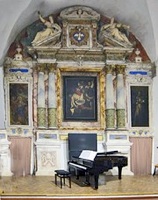
St Antony Abbot (ca. 1634)
Bishop Tegrimio Tegrimi commissioned a substantial programme of decoration of the churchfrom Giacomo Giorgetti in 1634. Only this panel of St Antony Abbot, which is on the altar on the right, survives.
Art from the Oratory
Annunciation (mid 14th century)

These large fresco fragments, which are attributed to Pace di Bartolo, were detached from the oratory and are now in the Pinacoteca Comunale.
Gonfalon (1468)
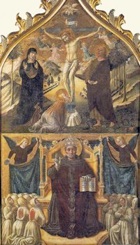
-
✴the Crucifixion with the Virgin and St John the Evangelist, with St Mary Magdalene at the foot of the cross, in the upper part of the composition; and
-
✴St Gregory the Great enthroned below, with kneeling members of the confraternity displaying their bleeding backs.
Return to Oratories of Assisi.
Return to Monuments of Assisi.
Return to Walk II.
Return to the home page on Assisi.
